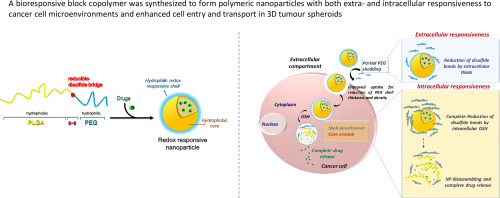Journal of Controlled Release ( IF 10.5 ) Pub Date : 2018-03-10 , DOI: 10.1016/j.jconrel.2018.03.011 Claudia Conte , Francesca Mastrotto , Vincenzo Taresco , Aleksandra Tchoryk , Fabiana Quaglia , Snjezana Stolnik , Cameron Alexander

|
In the treatment of lung cancer, there is an urgent need of innovative medicines to optimize pharmacological responses of conventional chemotherapeutics while attenuating side effects. Here, we have exploited some relatively unexplored subtle differences in reduction potential, associated with cancer cell microenvironments in addition to the well-known changes in intracellular redox environment. We report the synthesis and application of novel redox-responsive PLGA (poly(lactic-co-glycolic acid)) -PEG (polyethylene glycol) nanoparticles (RR-NPs) programmed to change surface properties when entering tumor microenvironments, thus enhancing cell internalization of the particles and their drug cargo.
The new co-polymers, in which PEG and PLGA were linked by ‘anchiomeric effector’ dithiylethanoate esters, were synthesized by a combination of ring-opening polymerization and Michael addition reactions and employed to prepare NPs. Non redox-responsive nanoparticles (nRR-NPs) based on related PLGA-PEG copolymers were also prepared as comparators. Spherical NPs of around 120 nm diameter with a low polydispersity index and negative zeta potential as well as good drug loading of docetaxel were obtained. The NPs showed prolonged stability in relevant simulated biological fluids and a high ability to penetrate an artificial mucus layer due to the presence of the external PEG coating. Stability, FRET and drug release studies in conditions simulating intracellular reductive environments demonstrated a fast disassembly of the external shell of the NPs, thus triggering on-demand drug release.
FACS measurements and confocal microscopy showed increased and faster uptake of RR-NPs in both 2D- and 3D- cell culture models of lung cancer compared to nRR-NPs. In particular, the ‘designed-in’ reductive instability of RR-NPs in conditioned cell media, the fast PEG release in the extracellular compartment, as well as a diminution of uptake rate in control experiments where extracellular thiols were neutralized, suggested a partial extracellular release of the PEG fringe that promoted rapid internalization of the residual NPs into cells.
Taken together, these results provide further evidence of the effectiveness of PEGylated reducible nanocarriers to permeate mucus layer barriers, and establish a new means to enhance cancer cell uptake of drug carriers by extra-and intra-cellular cleavage of protein- and cell-shielding hydrophilic blocks.
中文翻译:

氧化还原反应性聚乙二醇化纳米颗粒在2D和3D肺癌细胞模型中的吸收增强,对减少细胞外和细胞内环境具有敏感性
在肺癌的治疗中,迫切需要创新药物以优化常规化学疗法的药理学反应,同时减轻副作用。在这里,除了细胞内氧化还原环境的众所周知的变化之外,我们还利用了一些相对未开发的还原潜力的细微差异,这些差异与癌细胞微环境有关。我们报告了新型的氧化还原响应PLGA(聚(乳酸-乙醇酸))-PEG(聚乙二醇)纳米粒子(RR-NPs)的合成和应用,这些纳米粒子被编程为在进入肿瘤微环境时改变表面性质,从而增强了细胞的内在化颗粒及其毒品。
通过开环聚合反应和迈克尔加成反应的结合,合成了新的共聚物,其中PEG和PLGA通过“不对称效应子”二噻吩基乙酸酯连接在一起,并用于制备NP。还制备了基于相关PLGA-PEG共聚物的非氧化还原响应性纳米颗粒(nRR-NP)作为比较剂。获得了具有低多分散指数和负ζ电势以及多西紫杉醇的良好载药量的直径约120 nm的球形NP。由于存在外部PEG涂层,NP在相关的模拟生物流体中显示出延长的稳定性,并且具有穿透人工粘液层的高能力。在模拟细胞内还原环境的条件下的稳定性,FRET和药物释放研究表明,NP的外壳快速分解,
FACS测量和共聚焦显微镜显示,与nRR-NP相比,肺癌的2D和3D细胞培养模型中RR-NP的吸收增加且更快。特别是,条件细胞培养基中RR-NPs的“设计”还原不稳定性,细胞外区室中PEG的快速释放以及中和了细胞外硫醇的对照实验的摄取率降低,表明部分细胞外释放PEG条纹,从而促进残留NPs快速内化到细胞中。
综上所述,这些结果为聚乙二醇化的可还原纳米载体渗透粘液层屏障的有效性提供了进一步的证据,并建立了一种新的手段来通过蛋白质和细胞屏蔽亲水性蛋白的细胞外和细胞内裂解来增强癌细胞对药物载体的摄取。块。











































 京公网安备 11010802027423号
京公网安备 11010802027423号